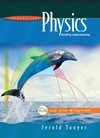PHYS 214 – Section 2
Spring 2007
Syllabus

|
Instructor: Dr Luca Bombelli E-mail: bombelli at olemiss.edu Lecture: Lewis 101, TuTh 9:30-10:45 Required Text: J Touger, Physics, Prentice Hall 2004; you should also have an interwrite PRS clicker (infrared version), and access to the publisher's site for online study materials and homework, WileyPlus. |
|
Description |
This is the second course of a two-course sequence on general physics, mainly for pre-med majors. (The companion course and prerequisite, offered in the Fall, is PHYS 213.) Students who enroll must also take, or have previously passed, the PHYS 224 lab or an equivalent lab course. We cover roughly the second half of the textbook. The main themes are: Electricity, magnetism, electromagnetic waves, optics, and topics from modern (XX century) physics, such as special relativity and some applications of quantum theory. Significant goals of this course are for students to improve their analytical reasoning and problem solving skills. Part of this consists in "applying equations" and "getting the right result", but students will be evaluated on a broader set of skills, including analyzing a problem and placing it in its proper context, as well as discussing general physics concepts in writing. |
|
(a student may choose to have homework assignments count less than listed below) Homework ... 15% (may change, but values will not be higher than these) A: .. 88% and up |
Homework: Homework will be assigned for each chapter we cover; assignments will be announced in class and posted on this website. Paper homework may not be accepted after the stated deadline, but students may be excused from turning in an assignment if there is a valid reason. Paper homework must be easy to read in terms of neatness, grammatically correct, and, even more importantly, should include an explanation of how you obtained your result: equations and numbers by themselves, even if correct, are not enough for full credit; pages must be stapled together, and have smooth (not torn) edges. Online homework may be assigned as well. The lowest homework grade will be dropped. Clickers: Most classes will begin with a quiz consisiting of multiple-choice questions to be answered using a "clicker"; those questions will be graded; the lowest quiz grade (or one missed quiz) will be dropped. In addition, other clicker questions will be asked during the lectures, but those will not be used for grading purposes. Tests: There will be two midterm tests and a final exam, consisting mostly of quantitative problems, but they will include conceptual questions as well. Students will be allowed to use a calculator, but no equation sheets, books or notes. Knowledge of the main equations from all chapters covered in PHYS 213 (a list is available in the review pages) will be assumed in each test, and the final will be comprehensive. There will normally be no make-ups for missed tests, but excused absences from tests will not count toward the grade. Absences: There is no attendance policy for the course, but keep in mind that you will be responsible for knowing what is said in class, answering any clicker questions that are asked of the class during a lecture, and absences from quizzes and tests count as zeros, unless they are justified. |
|
Note: If a change in the class policies became necessary during the semester, it would be discussed in class before being implemented. After this discussion, the change would be posted on this website. |
|